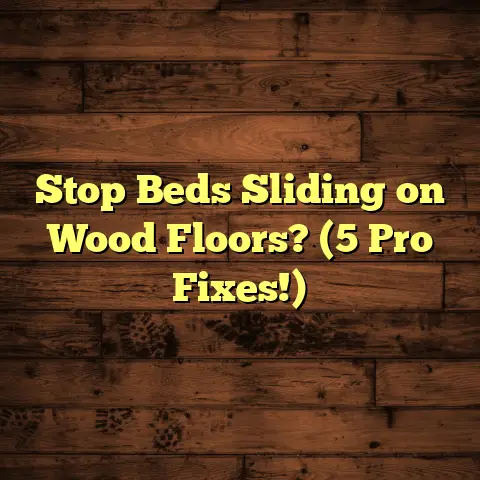Mold On Basement Floor How To Remove It?
Let’s face it: discovering mold on your basement floor is a major bummer. It’s that sinking feeling when you realize something’s not right in your home’s foundation (literally!). Basements, with their cool, dark, and often damp conditions, are basically mold’s dream vacation spot.
Did you know that the EPA estimates that indoor mold problems affect a significant percentage of homes? Some studies suggest it could be as high as 20-30%! And it’s not just about aesthetics; mold can trigger allergies, respiratory issues, and a whole host of other health problems.
I remember one client, Sarah, who called me in a panic. Her kids were constantly coughing, and she couldn’t figure out why. Turns out, a leaky pipe behind a finished wall had created the perfect breeding ground for mold. The air quality was terrible, and the mold was making everyone sick. We had to tear out the drywall, remediate the mold, and fix the leak. It was a big job, but Sarah was so relieved to finally have a healthy home again.
That’s why it’s so important to tackle mold problems head-on. Don’t ignore it, hoping it will magically disappear (spoiler alert: it won’t!). Let’s dive into understanding mold, identifying it, removing it safely, and preventing it from staging a comeback.
Section 1: Understanding Mold: Your Unwelcome Guest
So, what exactly is mold? It’s a type of fungus that thrives on organic matter. Think of it as nature’s little recycler, breaking down dead plants and animals. The problem is, it doesn’t discriminate; it’ll happily munch on your drywall, wood, carpet, and anything else organic it can find in your basement.
Mold reproduces through tiny spores that float in the air. These spores are everywhere, both indoors and outdoors. They’re just waiting for the right conditions – moisture, warmth, and food – to settle down and start growing.
The Usual Suspects: Types of Mold in Basements
There are thousands of different types of mold, but some are more common in basements than others. Here are a few of the usual suspects:
- Cladosporium: This is one of the most common types of mold, and it’s often found on fabrics, wood, and painted surfaces. It’s usually dark green or black.
- Aspergillus: Another common mold, Aspergillus can come in a variety of colors. It’s often found on food, but it can also grow on walls, floors, and carpets.
- Penicillium: You might recognize this name from the antibiotic penicillin. However, Penicillium mold can also be found in basements, especially in damp areas.
- Stachybotrys chartarum (Black Mold): This is the one everyone fears. Black mold is a greenish-black mold that’s often found in areas with high moisture levels. It’s been linked to a variety of health problems, although the exact nature and extent of these effects are still being studied.
Important Note: While “black mold” gets a lot of attention, any mold growth should be addressed promptly. Don’t get hung up on the color; focus on getting rid of it!
The Perfect Storm: Conditions for Mold Growth
Mold needs three key ingredients to thrive:
- Moisture: This is the big one. Mold needs water to grow, whether it’s from a leaky pipe, a flooded basement, condensation, or just high humidity.
- Food: Mold feeds on organic materials like wood, drywall, paper, and even dust.
- Warmth: Mold prefers temperatures between 40°F and 100°F (4°C and 38°C), which is pretty typical for most basements.
If you’ve got these three things going on in your basement, you’re basically inviting mold to the party.
The Health Risks: Why Mold Matters
I’m not a doctor, but I’ve seen firsthand the health problems mold can cause. Here are some of the common health risks associated with mold exposure:
- Allergic Reactions: Mold can trigger allergic reactions in sensitive individuals, causing symptoms like sneezing, runny nose, itchy eyes, and skin rashes.
- Respiratory Problems: Mold can irritate the lungs and airways, leading to coughing, wheezing, shortness of breath, and asthma attacks.
- Other Health Issues: Some studies have linked mold exposure to other health problems, such as headaches, fatigue, and neurological issues.
If you or your family members are experiencing any of these symptoms, it’s important to talk to your doctor and address the mold problem in your home.
Section 2: Identifying Mold on Basement Floors: Detective Work
Okay, so how do you know if you have mold on your basement floor? Here’s what to look for:
- Visual Signs:
- Discoloration: Mold can appear as black, green, brown, white, or even orange spots or patches.
- Fuzzy Growth: Mold often has a fuzzy or slimy texture.
- Stains: Water stains on walls or floors can be a sign of moisture problems that could lead to mold growth.
- Musty Odor: Mold often has a distinctive musty or earthy smell. If you notice a persistent musty odor in your basement, it’s a good idea to investigate further.
Time to Investigate: Inspecting Your Basement
Grab a flashlight and get ready to play detective! Here’s how to conduct a thorough inspection of your basement:
- Start with the Obvious: Check for visible mold growth on floors, walls, ceilings, and around windows and doors.
- Look for Water Damage: Pay attention to any signs of water damage, such as stains, peeling paint, or warped wood.
- Check Under Carpets and Rugs: Mold loves to hide under carpets and rugs, especially if they’re damp.
- Inspect Corners and Crevices: Mold often grows in corners and crevices where moisture can accumulate.
- Don’t Forget the Hidden Areas: Check behind furniture, inside closets, and in any other areas that are out of sight.
Finding the Source: Tracing the Moisture
Finding the source of the moisture is crucial for preventing mold from returning. Here are some common sources of moisture in basements:
- Leaky Pipes: Check for leaky pipes under sinks, around toilets, and in other areas where water pipes are located.
- Foundation Cracks: Cracks in the foundation can allow water to seep into the basement.
- Poor Drainage: If your yard slopes towards your foundation, rainwater can run into your basement.
- High Humidity: High humidity levels can cause condensation on walls and floors, creating a breeding ground for mold.
- Lack of Ventilation: Poor ventilation can trap moisture in the basement, making it more susceptible to mold growth.
Section 3: Preparing for Removal: Safety First!
Before you start scrubbing, it’s important to take some safety precautions to protect yourself from mold exposure.
Safety Gear: Gearing Up for Battle
Here’s the safety gear you’ll need:
- Mask: Wear an N-95 respirator mask to protect yourself from inhaling mold spores.
- Gloves: Wear waterproof gloves to protect your skin from mold and cleaning solutions.
- Eye Protection: Wear goggles or safety glasses to protect your eyes from mold spores and splashes.
- Protective Clothing: Wear old clothes that you can throw away after the job, or wear disposable coveralls.
Ventilation: Letting the Air Flow
Proper ventilation is essential during the mold removal process. Open windows and doors to allow fresh air to circulate. You can also use a fan to help ventilate the area.
Tools and Materials: Getting Equipped
Here’s a list of the tools and materials you’ll need for mold removal:
- Cleaning Solutions: Choose a cleaning solution that’s
effective against mold, such as:
- Vinegar: A natural and effective mold killer.
- Hydrogen Peroxide: Another natural option that can kill mold and disinfect surfaces.
- Commercial Mold Removers: These are specially formulated to kill mold and prevent it from returning. Follow the manufacturer’s instructions carefully.
- Scrub Brush: Use a stiff-bristled scrub brush to remove mold from surfaces.
- Sponges and Rags: You’ll need sponges and rags to apply cleaning solutions and wipe down surfaces.
- Spray Bottle: Use a spray bottle to apply cleaning solutions to moldy areas.
- Plastic Sheeting: Use plastic sheeting to seal off the affected area and prevent mold spores from spreading.
- Duct Tape: Use duct tape to secure the plastic sheeting.
- Trash Bags: Use heavy-duty trash bags to dispose of moldy materials.
- Shop Vacuum with HEPA Filter: A shop vacuum with a HEPA filter can help remove mold spores from the air.
Section 4: Step-by-Step Mold Removal Process: Operation Clean Sweep
Alright, let’s get down to business! Here’s a detailed, step-by-step guide on how to remove mold from your basement floor:
Step 1: Containment: Sealing Off the Area
- Seal off the affected area with plastic sheeting and duct tape to prevent mold spores from spreading to other parts of your home.
- Cover any vents or openings in the area with plastic sheeting and duct tape.
- Close doors to adjacent rooms and seal them with plastic sheeting and duct tape.
Step 2: Cleaning: Choosing Your Weapon
- Choose your cleaning solution. Here are a few options:
- Vinegar: Pour white vinegar into a spray bottle and spray it directly onto the moldy area. Let it sit for an hour, then scrub with a brush and wipe clean.
- Hydrogen Peroxide: Pour 3% hydrogen peroxide into a spray bottle and spray it directly onto the moldy area. Let it sit for 10 minutes, then scrub with a brush and wipe clean.
- Commercial Mold Remover: Follow the manufacturer’s instructions carefully. These products are often stronger than vinegar or hydrogen peroxide, so be sure to wear appropriate safety gear.
Step 3: Scrubbing: Elbow Grease Required
- Apply the cleaning solution to the moldy area using a spray bottle, sponge, or rag.
- Scrub the area vigorously with a stiff-bristled brush to remove the mold.
- Rinse the area with clean water and wipe it dry.
- Repeat the process if necessary until all the mold is gone.
Important Note: The scrubbing technique may vary depending on the type of flooring you have.
- Concrete: Concrete is porous, so you may need to scrub more aggressively to remove mold from the surface.
- Tile: Tile is non-porous, so mold should be easier to remove. However, you may need to pay attention to the grout lines, as mold can often grow there.
- Carpet: Removing mold from carpet can be tricky. If the mold is extensive, it may be necessary to remove and replace the carpet.
Step 4: Drying: The Key to Prevention
- Dry the area thoroughly after cleaning to prevent mold from returning.
- Use a fan to circulate air and speed up the drying process.
- Consider using a dehumidifier to remove moisture from the air.
Step 5: Disposal: Getting Rid of the Evidence
- Place all moldy materials (e.g., rags, sponges, brushes) in heavy-duty trash bags.
- Seal the trash bags tightly and dispose of them properly.
- Clean your tools with a bleach solution (1 part bleach to 10 parts water) to kill any remaining mold spores.
- Wash your clothes in hot water with detergent to remove any mold spores.
Section 5: Preventing Future Mold Growth: Staying Vigilant
Once you’ve removed the mold, it’s important to take steps to prevent it from returning. Here are some strategies:
- Manage Humidity Levels: Use a dehumidifier to keep humidity levels below 50%.
- Ensure Proper Ventilation: Open windows and doors regularly to allow fresh air to circulate. Install exhaust fans in bathrooms and kitchens to remove moisture.
- Fix Leaks Promptly: Repair any leaks in your plumbing or foundation as soon as possible.
- Improve Drainage: Make sure your yard slopes away from your foundation to prevent water from running into your basement.
- Use Mold-Resistant Products: When renovating or repairing your basement, use mold-resistant drywall, paint, and flooring.
- Regularly Inspect Your Basement: Check for signs of mold growth on a regular basis, especially in areas that are prone to moisture.
I always recommend my clients invest in a good dehumidifier with an automatic shut-off. This will help maintain a consistent humidity level and prevent mold from getting a foothold.
Section 6: When to Call Professionals: Knowing Your Limits
Sometimes, the mold problem is too big to handle on your own. Here are some scenarios where you should consider hiring a mold remediation professional:
- Extensive Mold Growth: If the mold covers a large area (more than 10 square feet), it’s best to call a professional.
- Significant Health Concerns: If you or your family members are experiencing significant health problems related to mold exposure, it’s important to consult with a doctor and hire a professional mold remediation company.
- Hidden Mold: If you suspect that there’s mold growing behind walls or in other hidden areas, a professional can use specialized equipment to locate and remove it.
- You’re Not Comfortable Doing It Yourself: Mold remediation can be a messy and potentially hazardous job. If you’re not comfortable doing it yourself, it’s best to leave it to the professionals.
Choosing a Qualified Professional: Due Diligence
If you decide to hire a mold remediation professional, here are some tips on how to select a qualified specialist:
- Check for Certifications: Look for companies that are certified by organizations like the Institute of Inspection, Cleaning and Restoration Certification (IICRC) or the National Organization of Remediators and Mold Inspectors (NORMI).
- Ask for References: Ask the company for references from previous clients and check them thoroughly.
- Get Multiple Bids: Get bids from several different companies and compare their prices and services.
- Read the Contract Carefully: Make sure you understand the terms of the contract before you sign it.
I always tell my clients to ask potential remediation companies about their experience, their process, and their guarantee. A reputable company will be transparent and willing to answer all of your questions.
Conclusion: Breathe Easy Again
Dealing with mold on your basement floor can be a daunting task, but it’s important to address it promptly and effectively. By understanding mold, identifying it early, removing it safely, and preventing it from returning, you can protect your home and your health.
Remember, if you’re not comfortable tackling the problem yourself, don’t hesitate to call in the professionals. A clean, mold-free basement can improve your home’s air quality, increase its value, and give you peace of mind.
Now, I’d love to hear from you! Have you ever dealt with mold in your basement? What challenges did you face? Share your experiences and questions in the comments below. Let’s help each other create healthier and happier homes!





